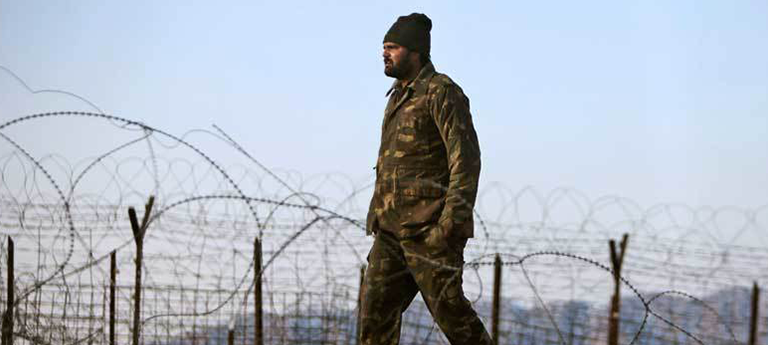Recommitted themselves to the 2003 ceasefire arrangement at the Line of Control and agreed to address the‘core issues’that could undermine peace and stability.
The surprise advertisement was made in a common statement by the colors of the two countries on a‘hotline contact’between their directors general military operations (DGMOs), which had supposedly taken place a day before.
The discussion between Pakistani DGMO Maj Gen Nauman Zakaria and his Indian counterpart Lt Gen Paramjit Sangha was described as “ free” and “ foursquare” and held in a “ cordial atmosphere”.
The agreement reached between them took effect a night before under which ceasefire violations at the LoC had ended from night of Feb 24 and 25.
Qureshi terms agreement a positive development; Delhi says India solicitations normal neighbourly relations with Pakistan
“ Both sides agreed for strict observance of all agreements, understandings and cease blasting along the LoC and all other sectors, with effect from night24/25 February 2021,” said a statement.
Pakistan and India had in November 2003 agreed to cease fire along the LoC and the Working Boundary. The agreement held for a many times, but regular violations have passed since 2008. A sharp shaft in the armistice breaches has, meanwhile, been witnessed since 2014 when Prime Minister Narendra Modi came to power in India. Last time Indian colors committed over ceasefire violations in which 28 people were martyred.
The statement said the two sides had concurred on reviving the being mechanisms — hotline contact and flag meetings — for dealing with “ any unlooked-for situation or misreading”.
Hotline contact is one of the oldest military confidence- structure measures between Pakistan and India. The hotline contact was firstly established in 1971, but its use followed ups and campo in the relations. The two sides had in their clerk- position addresses in August 1992 agreed to renew DGMOs’ communication via the hotline on a daily base. The practice, still, couldn’t come a endless point and remained dependent on the state of bilateral relations.
One of the crucial corridor of the statement that didn’t get important attention was the one related to commitment to addressing core issues persecuting the ties.
“ In the interest of achieving mutually salutary and sustainable peace, the two DGMOs agreed to address each other’s core issues/ enterprises which have propensity to disturb peace and lead to violence,” the statement noted.
This effectively meant that the understanding reached between the two sides went beyond an agreement on clinging to the 2003 arrangement and carried a commitment to addressing the real issues — Kashmir from Pakistani perspective.
The advertisement, whether by coexistence or design, came on the dusk of the alternate anniversary of the February 2019 upstanding skirmishes between the two countries following the Pulwama attack.
How the agreement reached?
The outgrowth of the DGMOs discussion, held after a long time, was significant, but people were curious about knowing how the two sides reached this point amidst all the acrimony between them.
With no satisfying explanation coming either from Islamabad or Delhi, politic spectators believed that it was a result of some backchannel addresses that may have been at work.
But who were involved in it?
Sources say it had been taking place between the intelligence agencies of the two countries with the blessings of the separate military leaderships. Nearly everyone agrees that not numerous people were in the circle on both sides.
In India it was rumoured that Indian National Security Adviser Ajit Doval was involved in the backchannel dialogue from his side. Some Indian media organisations suspected that Special Assistant to the Prime Minister on National Security Moeed Yusuf was the person on the Pakistani side.
Mr Yusuf, still, through a tweet denied that he was part of any backchannel addresses. He twittered “ No similar addresses have taken place between me and Mr Doval.”
In another tweet, he said the agreement redounded through DGMOs dialogue “ done intimately and professionally through the direct channel.”
In an audio clip that before in the day made rounds on social media, Mr Yusuf could be heard saying “ These effects be behind the scenes. A lot of trouble goes into it. Do you suppose this happed without trouble and without pressure.”
Mr Yusuf had in an interview with Karan Thapar in October 2020, which was the first by a Pakistani functionary with any Indian media since annexation of enthralled Kashmir by India in August 2019, said India had transferred communication expressing desire for addresses.
It should also be recalled that Army Chief Gen Qamar Bajwa had in two statements before this month made gesture for resolving pressures. Speaking at the PAF Academy, he said “ It’s time to extend hand of peace in all directions.”
Another significance of the agreement is that the Pakistan government engaged with India despite setting the conditions that it would not do so until and unless India cancelled the annexation of held Kashmir and ended the mortal rights violations there.
‘ Positive development’
Foreign Minister Shah Mahmood Qureshi ate the agreement saying it was a positive development. “ It could be a good launch for the future. India will have to abide by this ceasefire agreement with sincerity. How can we make progress on the issue of enthralled Kashmir unless the terrain is conducive,” he said.
Mr Qureshi believed that the agreement could stop the situation from farther deterioration. “ Pakistan seeks peaceful relations with its neighbours,” he added.
Indian Ministry of External Affairs, in its response, said “ India solicitations normal neighbourly relations with Pakistan. We’ve always maintained that we’re committed to addressing issues, if any, in a peaceful bilateral manner.”






